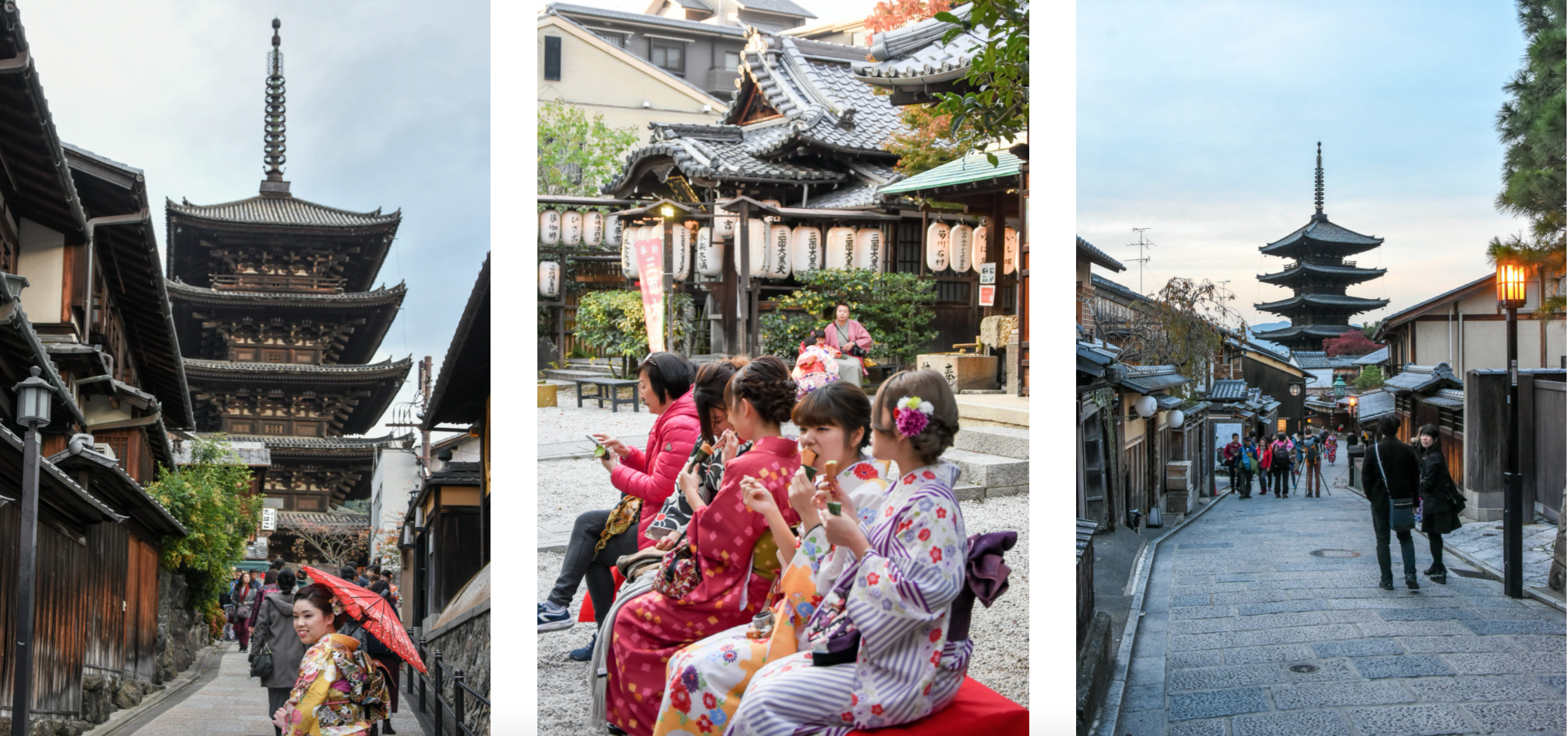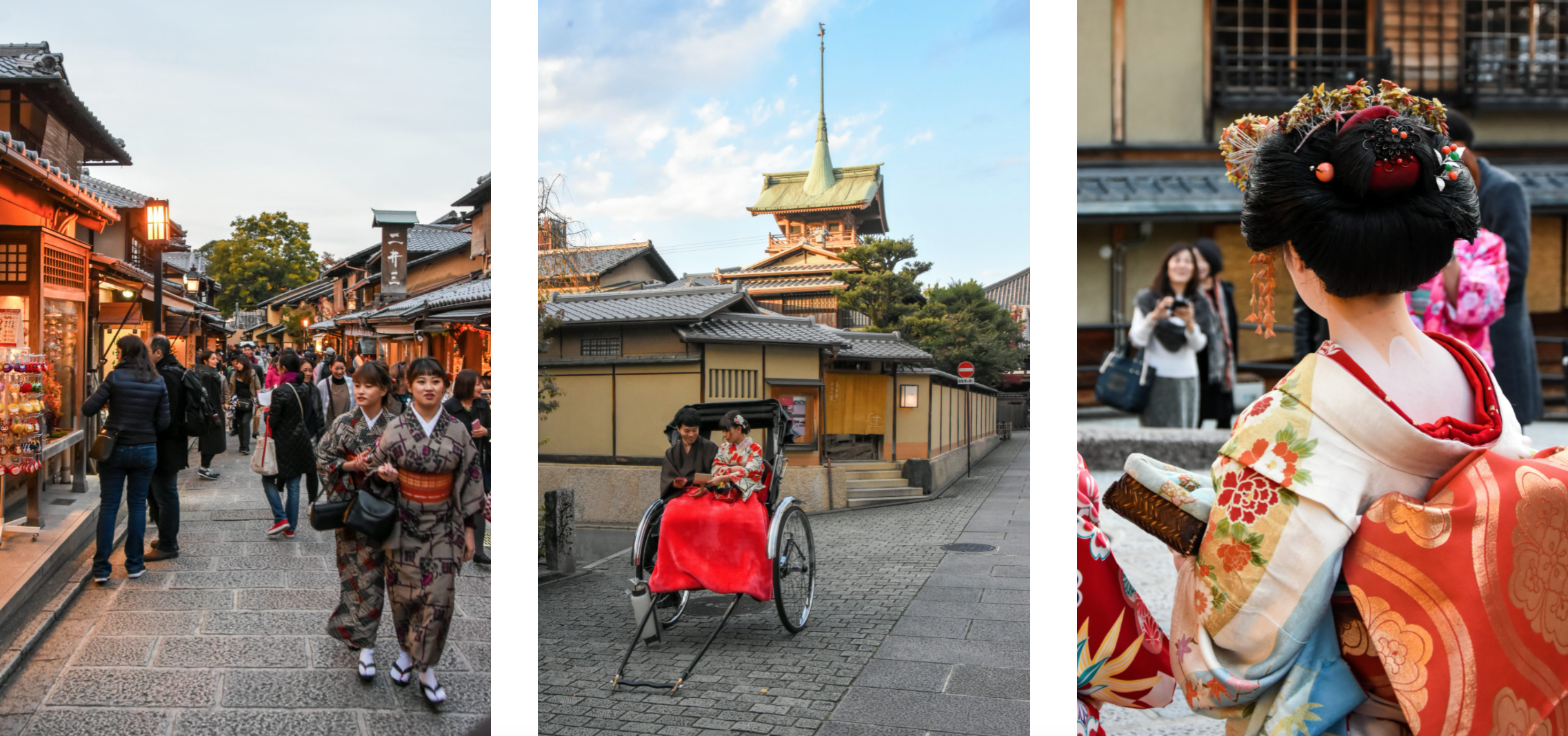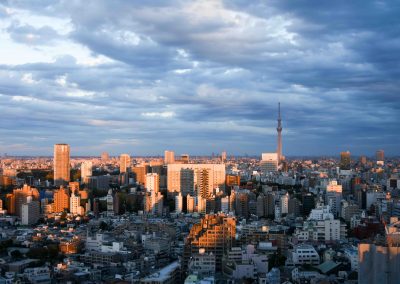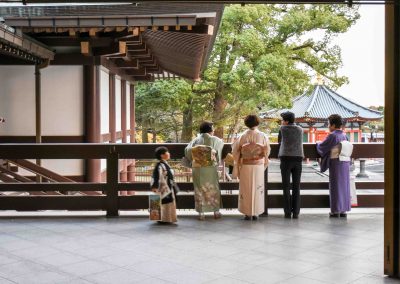What to see in Kyoto?
My trip to Japan was one of the trips of my life and here at home, my man doesn’t shut up about wanting to return, as soon as the world allows it. Therefore, it is unacceptable that I have so few posts about the country of the rising sun!
We went to Japan in November 2017, in mid-autumn (Koyo, as they call the colors of that time), and it was in Kyoto that we were able to appreciate this beauty that nature offers us once a year.
Kyoto is known as the “City of Samurais” or as the “Old Capital” since for more than a millennium, it was the capital of the Imperial Court of Japan (between 794 and 1868, when it was replaced by Tokyo). Despite being ravaged by wars, fires, and earthquakes during these eleven centuries as an imperial capital, Kyoto was spared most of the destruction during World War II. With over 1,600 Buddhist temples and 400 Shinto temples and palaces and gardens, it is one of the best-preserved cities in Japan, and that’s why I start this “return to Japan” with it.
What to see then in Kyoto? I decided to organize this list by two themes – “Temples and Palaces” and “Other Things” and the list is ordered by personal preference.
Let us start with the countless Kyoto temples, which are often difficult to choose from:
- Fushimi Inari Taisha Temple
- Kinkaku-ji (Temple of the Golden Pavilion)
- Kyomizu-dera Temple
- Ginkaku-ji Temple (Silver Pavilion)
- Nanzenji
- Kyoto Imperial Palace
And in relation to “Other Things” we have:
- Higashiyama and Gion districts
- Arashiyama district
- Fushimi Inari food market
- Nishiki Market
.
WHAT TO SEE IN KYOTO? FUSHIMI INARI TAISHA TEMPLE
Inari is the Shinto god of foxes, fertility, rice, agriculture, industry, and success in general. The Fushimi Inari temple is located at the base of the mountain of the same name and includes trails up the mountain to many smaller temples that span 4 kilometers. These paths are home to more than 3000 tori, each donated by a branch of Japanese business, since Inari was seen as the patron of business – what is written on the tori is precisely the name of the person or entity that made the donation.
This infinite alignment of toris makes this place special and unique! A lot, but a lot, bigger than we imagined, we walked for about three hours and only covered half the route.
⏰ Always open
💴 Free
📌 The temple is located very close to Inari Station, on the JR Nara Line, 5 minutes from Kyoto Station (if you have a JR Pass this train is included, if you don’t, it costs 150yen). In Japan it is essential to have access to the internet, explained in this post, so the easiest thing is to put the destination on Google Maps and this explains step by step what transportation you should take and the different price options. Also remember that there is a daily bus ticket in Kyoto, at the time it costed 500yen, and it pays off from the third trip.
.
.
.
WHAT TO SEE IN KYOTO? KINKAKU-JI (GOLDEN PAVILION TEMPLE)
The Kinkaku-ji Temple is another must-see in Kyoto, although one of the most crowded. It is also known as the Golden Pavilion because the entire building, except the ground floor, is covered in gold leaf.
Surrounded by a Kyōko-chi (mirrored lake) this is a Zen temple. It was built in 1397 but in 1950 the pavilion was set on fire by a monk who suffered from mental disorders, so the current construction is from 1955. This is a very Japanese habit of rebuilding the temples as they were in the past. Many of the temples we see today in Japan were rebuilt after World War II.
Unfortunately, you can only visit the Pavilion gardens and not the interior of the building, but it is possible to observe the statues on the first floor, if you look closely from the other side of the lake, as the doors are usually open. Each floor has a different architectural style.
⏰ Open every day from 9 am to 5 pm
💴 400 yen
📌 We can reach Kinkakuji temple from Kyoto station by taking buses 101 or 205, which take about 40 minutes (230 yen per trip). Alternatively, it can be quicker and more reliable to take the metro to Kitaoji Station (15 minutes, 260 yen) and then a bus (10 minutes, 230 yen, buses 101, 102, 204 or 205) from there to Kinkakuji
.
.
.
WHAT TO SEE IN KYOTO? KIYOMIZU-DERA TEMPLE
Kyomizu-dera means Temple of Pure Water and owes this name to a waterfall that descends from the mountains, and that passes through this Buddhist complex.
Kyomizu-dera borders the city with the forest and has one of the most beautiful views of Kyoto. One of its most interesting features is that it doesn’t have a single nail, the whole building, even more impressive when we visited its wooden balcony 13 meters high in relation to the ground (in my case, when I went there, it was to be recovered, so I walked inside, but I had neither the view nor an idea of the whole building from the outside).
The waterfall is located at the base of the main hall and the waters are divided into three distinct streams, where visitors use cups attached to long poles to drink. The water in each stream is said to have a different benefit – longevity, success in school, and a happy love life. However, drinking from all three is considered greedy.
Part of the fun of visiting Kiyomizu-dera is arriving at the temple along the steep, busy streets of the atmospheric Higashiyama District, which I speak of below.
⏰ Open every day from 6 am to 6 pm (until 6:30 pm on weekends and holidays from mid-April to July and every day in August and September)
💴 400 yen
📌 A partir da estação de Kyoto com os autocarros 100 ou 206 (15 minutos, 230 yen). Sair nas paragens Gojo-zaka ou Kiyomizu-michi, a partir daí são 10min a pé, colina acima, até ao templo. Como alternativa, Kiyomizudera fica a cerca de 20 minutos a pé da Estação Kiyomizu-Gojo.
.
.
.
WHAT TO SEE IN KYOTO? GINKAKU-JI TEMPLE (OR SILVER PAVILION)
The Ginkaku-ji temple was the first one we visited, since our hostel was in this neighborhood. So it has a special place in the heart because, despite the fact that it was raining that day, it was the first contact with the explosion of autumn colors!
Ginkaku-ji is also known as the Silver Pavilion and is a “grandchild” of the Golden Pavilion that we can visit on the other side of the city. In 1482, the shogun Ashikaga Yoshimasa built a villa on the grounds of the temple, modeling it on the basis of Kinkaku-ji, the villa of his grandfather. After Yoshimasa’s death in 1490, this villa was transformed into a Zen temple.
This particular temple has a high artistic relevance, since, being the home of an art-obsessed shogun, the Silver Pavilion has become a center of contemporary culture, known as the Higashiyama Culture, in contrast to the Kitayama Culture of the times of his grandfather. Unlike the Kitayama Culture, which remained limited to Kyoto’s aristocratic circles, the Higashiyama Culture had a wide impact across the country. The arts developed and refined over time include the tea ceremony, flower arrangements, noh theater, poetry, garden design, and architecture.
Despite its name, the Silver Pavilion was never covered in silver. Instead, it is believed that the name came up as a nickname more than a century after the construction of the building, to contrast it with the Golden Pavilion. Alternatively, it is explained that the moonlight reflected in the building’s dark exterior (which used to be covered with black lacquer in the past) gave it a silvery appearance.
The Temple consists of several buildings, in which we can see the painting work on the paper walls, from the outside, and beautiful gardens, lakes and bridges, highlighting the meticulously maintained sand garden, known as “Sea of Silver Sand” , with a huge sand cone called “Moon Observation Platform”, which some say is a reference to Mount Fuji.
⏰ Open every day from 8:30 am to 5:00 pm (or from 9 am to 4:30 pm between December and February)
💴 500 yen
📌 Take bus number 5, 17 or 100 from Kyoto station, which takes about 35-40 minutes (230yen). Alternatively, we can reach Ginkakuji on foot along the Philosopher’s Path from the Nanzenji temple in about 30-45 minutes (I did this, but on the other direction)
.
.
WHAT TO SEE IN KYOTO? NANZENJI TEMPLE
From the Silver Pavilion, we can then take the Philosopher’s Path. Approximately two kilometers long, the path starts near Ginkaku-ji and ends in the Nanzenji district. The path is named after Nishida Kitaro, one of Japan’s most famous philosophers, who allegedly practiced meditation while walking along this cherry-covered canal on his daily commute to Kyoto University.
Nanzenji is one of the most important Zen temples in all of Japan. It is the main temple of one of the Rinzai sects of Japanese Zen Buddhism and includes several sub-temples, which make the already large complex of temple buildings even larger.
The grounds of the central Nanzenji temple are free to access, and you pay individually to enter the temple and sub-temple buildings. We first come across the huge Sanmon gate, which extends over the treetops. The gate was built in 1628 by the ruling Tokugawa clan for soldiers who died in the siege of Osaka Castle in 1615. It is possible to climb up to the gate’s porch, from where the view extends across the city.
⏰ Open every day from 8:40 am to 5 pm (or until 4:30 pm between December and February). Some of the temples closed between December 28th and 31st
💴 Free entrance to the temple area. To enter each temple, prices vary between 400 and 600yen per temple.
📌 Nanzenji is a 5-10 minute walk from the Keage metro station (260yen from Kyoto station) or a 5-10 minute walk from the nearest bus stop, Nanzenji-Eikando-michi (35 minutes, 230yen from Kyoto station, bus number 5). Another alternative is to walk from Ginkaku-ji, as I did, through the Philosopher’s Path.
.
.
WHAT TO SEE IN KYOTO? IMPERIAL PALACE
The Kyoto Imperial Palace (Kyōto Gosho) used to be the residence of Japan’s imperial family until 1868 when the emperor and the capital were moved from Kyoto to Tokyo. It is located in the spacious Kyoto Imperial Park, an attractive park in the center of the city that also includes the Imperial Palace of Sento and some other attractions.
The complex is surrounded by long walls and consists of several gates, corridors, and gardens. The enthronement ceremonies of the emperors Taisho and Showa were still held in the main hall of the palace, but now the enthronements have also passed to the Imperial Palace in Tokyo.
Previously accessible only on guided tours that required reservations in advance, the grounds of the palace can now be explored freely (although guided tours in English are still available). Visitors can see the buildings and gardens of the palace, but entering any of the buildings is not allowed. Still, it is one of the best places where you can see the interiors of the rooms.
The 1300 meters long and 700 meters wide park also serves as a leisure space for tourists and residents, with wide and attractive gravel paths, lawns and groves.
⏰ Closed on Mondays and from December 28th to January 4th. From 9 am to 5 pm (between April and August), from 9 am to 4:30 pm (September and March) and from 9 am to 4 pm (between October and February). Last entry 40min before closing.
💴 Free
📌The Kyoto Imperial Palace is a short metro ride from Kyoto Station, along the Karasuma Line. Get off at Marutamachi (7 minutes, 260 yen) or at Imadegawa station (10 minutes, 260 yen). Imadegawa station is closer to the Imperial Palace entrance gate than Marutamachi station.
.
WHAT TO SEE IN KYOTO? DISTRICTS OF HIGASHIYAMA AND GION
Higashiyama’s district is one of the best-preserved historic districts in the city and a great place to experience ancient and traditional Kyoto, especially between the Kiyomizudera Temple and Yasaka Shrine, where the narrow streets, wooden buildings, and traditional shopping shops evoke the feel of the old capital. This is the district that corresponds to our image of the city of Kyoto (I say this because the center is much more modern than I expected).
Higashiyama streets are lined with small shops, cafes, and restaurants that have been serving tourists and pilgrims for centuries, selling local specialties such as Kiyomizu-yaki pottery, sweets, pickles, handicrafts, and other souvenirs. It is a neighborhood full of life, where we can see many girls in kimono (usually tourists from other Asian countries who rent the typical costume for a day), we can try for free what is sold in each café, visit stores of the universes we love, like Ghibli’s, or even come across geishas!
Gion is Kyoto’s most famous geisha district, located around Shijo Avenue between Yasaka Shrine and Kamo River. One of the two biggest attractions is its high concentration of traditional machiya wooden houses. Due to the fact that property taxes were previously based on the street façade, the houses were built with narrow façades only five to six meters wide, but then they are up to 20 meters deep.
Between the restaurants are several ochaya (tea houses), Kyoto’s most exclusive and expensive restaurants, where guests have fun with maiko (geisha apprentices) and geiko (the word for gueixa in the Kyoto dialect).
⏰ N/A
💴 Free
📌 To visit both districts, from Kyoto station, take bus number 100 or 206 in the direction of Kiyomizudera. Get off at Gion stop (15 minutes, 230 yen). You can also reach the district with a 10-15 minute walk from Gion-Shijo station (Keihan line) or Kawaramachi station (Hankyu line).
.
.
ARASHIYAMA DISTRICT
Arashiyama is a pleasant and touristic district on the western outskirts of Kyoto and has been a popular destination since the Heian period (794-1185) when nobles enjoyed its natural setting. One of the most famous things in this district is its Bamboo Grove, but this district has a lot more to offer!
My suggestion in Arashiyama is to get lost! Especially in the northern part of the neighborhood, after crossing the (very short) Bamboo Grove, which starts to be less touristy and where we find several temples in which we can see the Japanese in fact living their lives and their relationship with faith. But some of the most important places to visit is the Tenryuji temple, classified as one of Kyoto’s five great Zen temples, and the Togetsukyo bridge where we can observe the relationship between the mountain, the city, and the river.
Arashiyama becomes more attractive (and bustling) around the beginning of April and in the second half of November, when the cherry trees explode in bloom or when the autumn colors reach their exponent.
⏰ N/A
💴 Free
📌 The fastest access from the Kyoto station to Arashiyama is provided by the JR Sagano Line (also known as the JR Sanin Line). The one-way trip to Saga-Arashiyama Station takes 15 minutes and costs 240yen (or free if you have a JR Pass). From Saga-Arashiyama Station, the center of Arashiyama can be reached in 5 to 10 minutes on foot. There are also several alternatives by train or bus from various districts of Kyoto, although it is advisable to go by train as usually there is traffic. The best method is to consult Google Maps to understand what is the fastest, easiest, and most economical way to get around.
.
.
WHAT TO SEE IN KYOTO? FUSHIMI INARI FOOD MARKET
After a long walk under 3000 tori, the food market outside Fushimi Inari is the answer we needed. Stalls with noodles, ramen, tayakis (a hot cake like a waffle, in the shape of a fish with a very typical red bean filling), mochis, skewers, and many other things that I can’t name, but that look great. In addition to that, it gives us the opportunity to try various things at very affordable prices.
⏰ ?
💴 Free entrance. Affordable street food prices.
📌 At the exit of Fushimi Inari temple
.
NISHIKI MARKET
Nishiki Market is a shopping street that spans through five blocks, flanked by more than one hundred shops and restaurants. Known as the “Kyoto Kitchen”, this lively market specializes in everything related to food and cooking utensils, and is a great place to find seasonal foods and Kyoto specialties, such as Japanese sweets, pickles, dried seafood, and sushi. Nishiki Market has a pleasant yet bustling atmosphere that is inviting for those who wish to explore the variety of culinary delights for which Kyoto is famous for.
In some stores it is possible to try the products before buying. There are also some small restaurants that sell ready-made food and in others it is possible to sit down. The market has a history of several centuries and many stores have been operated by the same family for several generations. It all started as a fish-selling district, with the first store opened around 1310. A wide variety of stores later moved in, and the area moved from a wholesale to a retail market. Today, it remains an important market for Kyoto and is usually full of locals and tourists.
It is also very interesting that, across the market, we find several temples and shrines, demonstrating how devout this nation is.
⏰ Depending on the stores, they may close on Wednesdays or Sundays. Typical hours from 9am to 6pm, also depends on each store.
💴 Free access
📌Nishiki Market Street is parallel to Shijo Avenue, one block to the north. It can be reached on foot in less than five minutes from Shijo station, Karasuma line (4 minutes, 220yen from Kyoto station) or from Karasuma or Kawaramachi stations, on Hankyu line.
.
And this is my list of what to visit in Kyoto. This is the city with more temples, sub-temples, shrines, and palaces, so the list can be endless. In addition to that, just an hour away by train, we are in Nara, the city of the deer, and the temple with the biggest Buddha of Japan. The chances are endless ☺️
If you liked this post and want to read more about my trip to Japan, you can visit the following posts:






















